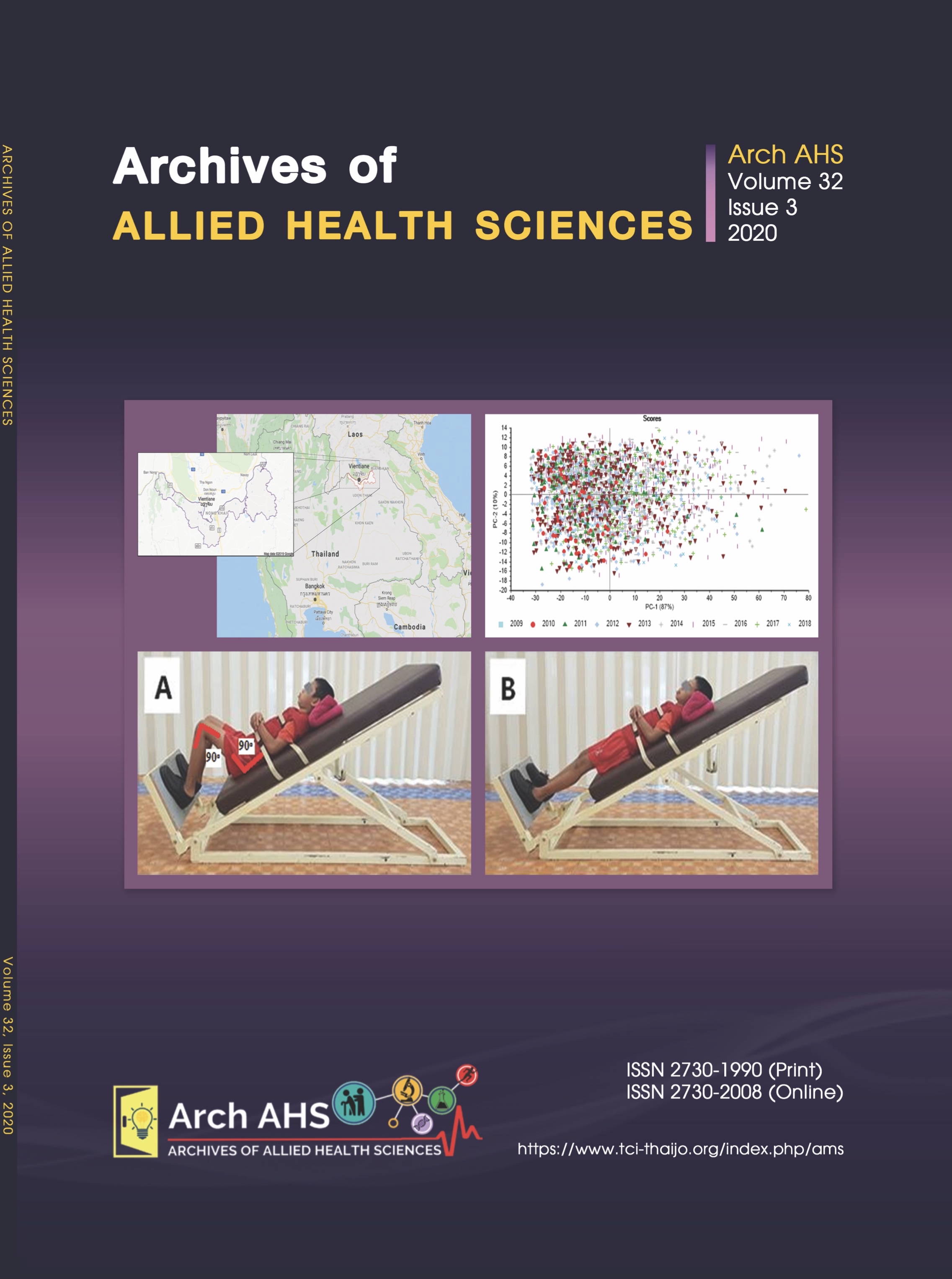Clinical chemistry normal ranges of healthy adult population in Nong Khai, Thailand
Main Article Content
Abstract
Normal range is a range of values used for clinical decision-making in early diagnosis, prediction and therapeutic monitoring of diseases. Due to the lack of a locally-established normal range, western population ranges acquired from reagent companies are commonly used for patients. Clinical normal ranges are in high demand for clinical trials and practice studies. Improvement of the normal range for the population in northeastern Thailand would be valuable for the development of healthcare quality. A newly-established range could act as control for a normal population for laboratory testing in nearby regions and countries. This study was initiated in October 2553 and lasted until May 2561 using 2,589 healthy adults who visited a hospital in Nong Khai, Thailand for health check-ups. In terms of laboratory testing, 6 clinical chemistry tests consisted of AST, ALT, ALP, Creatinine, HDL, and LDL. For data management and statistical analysis, STATA 10.1 software was used to manage and analyze the laboratory results data. Each group of samples was tested with mean, median and percentile range for all parameters to establish new normal ranges for the population. Data mining and a filtering model were created based on normal reference ranges. This model was used to filter only a population of healthy adults. The dataset of 91,829 recorded laboratory results from 9,398 people, with only 30,296 records from 1,051 men and 1,538 women enlisted for further study. This study provides a simple guideline that can serve as a model for clinical laboratories intending to establish their own normal ranges with local data.
Article Details

This work is licensed under a Creative Commons Attribution-NonCommercial-NoDerivatives 4.0 International License.
References
Ashwood ER, Burtis CA, Tietz NW. Tietz fundamentals of clinical chemistry: Elsevier; 2001.
Solberg HE. The IFCC recommendation on estimation of reference intervals. The RefVal program. Clinical Chemistry and Laboratory Medicine (CCLM) 2004; 42(7): 710-4.
Horn PS, Pesce AJ. Effect of ethnicity on reference intervals. Clinical chemistry 2002; 48(10): 1802-4.
Nduka N, Aneke C, Maxwell-Owhochuku S. Comparison of some haematological indices of Africans and Caucasians resident in the same Nigerian environment. Haematologia 1988; 21(1): 57-63.
Rödöö P, Ridefelt P, Aldrimer M, Niklasson F, Gustafsson J, Hellberg D. Population-based pediatric reference intervals for HbA1c, bilirubin, albumin, CRP, myoglobin and serum enzymes. Scandinavian journal of clinical and laboratory investigation 2013; 73(5): 361-7.
Kratz A, Ferraro M, Sluss PM, Lewandrowski KB. Laboratory reference values. N Engl J Med 2004; 351: 1548-64.
Furruqh S, Anitha D, Venkatesh T. Estimation of reference values in liver function test in health plan individuals of an urban south Indian population. Indian J Clin Biochem 2004; 19(2): 72-9.
Yadav D, Mishra S, Gupta M, John PJ, Sharma P. Establishment of reference interval for liver specific biochemical parameters in apparently healthy north Indian population. Indian J Clin Biochem 2013; 28(1): 30-7.
Lugada ES, Mermin J, Kaharuza F, Ulvestad E, Were W, Langeland N, Asjo B, Malamba S, Downing R. population-based hematologic and immunologic reference values for a healthy Ugandan population. Clin Diagn Lab Immunol 2004; 11(1): 29-34.
Lim E, Miyamura J, Chen JJ. Racial/ethnic-specific reference intervals for common laboratory tests: a comparison among Asians, Blacks, Hispanics, and White. Hawai’i J Med Public Health 2015; 74(9): 302.
US Food and Drug administration. “Replacement Reagent and Instrument Family Policy” for in vitro diagnostic (IVD) devices; 2003 [cited 2019 Oct 21]. Available from: https://www.fda.gov/media/111186/download.
Area of each district in Nong Khai Province [Internet]. [cited 2020 Dec 10]. Available from: http://www.e-report.energy.go.th/area/Nongkai.htm
The Royal Gazette published the number of citizens across the Kingdom 66.5 million people, [Internet]. [cited 2020 Dec 10]. Available from: https://moe360.blog/2020/02/01/ ราชกิิจจานุุเบกิเผยแพร่-2/
Clinical and Laboratory Standards Institute. Defining, establishing, and verifying reference
intervals in the clinical laboratory; approved guideline. CLSI Document C28-A3 (3rd Edition). 2008.
Reed AH, Henry RJ, Mason WB. Influence of statistical method used on the resulting estimate of normal range. Clinical chemistry 1971; 17(4): 275-84.
Kang YG, Suh E, Lee JW, Kim DW, Cho KH, Bae CY. Biological age as a health index for mortality and major age-related disease incidence in Koreans: National health Insurance service–health screening 11-year follow-up study. Clin Interv Aging 2018; 13: 429.
Royston P. Approximating the Shapiro-Wilk W-Test for non-normality. Statistics and computing 1992; 2(3): 117-9.
General Assembly of the World Medical Association. World Medical Association Declaration of Helsinki: ethical principles for medical research involving human subjects. J Am Coll Dent 2014; 81(3): 14.
Eller LA, Eller MA, Ouma B, Kataaha P, Kyabaggu D, Tumusiime R, Wandege J, Sanya R, Sateren WB, Wabwire-Mangen F, Kibuuka H. Reference intervals in healthy adult Ugandan blood donors and their impact on conducting international vaccine trials. PLOS one 2008; 3(12): e3919.
Pereira P. ISO 15189: 2012 Medical laboratories-Requirements for quality and competence.
Joint Commission International. Joint Commission International; 1017 [cited 2019Oct10]. Available from: https://www.jointcommissioninternational.org/assets/3/7/JCI_Standards_for_Laboratories_STANDARDSONLY.
Lima DC, dos Santos AM, Araujo RG, Scarminio IS, Bruns RE, Ferreira SL. Principal component analysis and hierarchical cluster analysis for homogeneity evaluation during the preparation of a wheat flour laboratory reference material for inorganic analysis. Microchemical Journal 2010; 95(2): 222-6.
Dobos L, Abonyi J. On-line detection of homogeneous operation ranges by dynamic principal component analysis based time-series segmentation. Chemical Engineering Science 2012; 75: 96-105.
Joint Specialty Committee on Renal Medicine (Great Britain), Renal Association (Great Britain). Chronic kidney disease in adults: UK guidelines for identification, management and referral. Royal College of Physicians.
Pottel H, Vrydags N, Mahieu B, Vandewynckele E, Croes K, Martens F. Establishing age/sex related serum creatinine reference intervals from hospital laboratory data based on different statistical methods. Clinica chimica acta 2008; 396(1-2): 49-55.
Yang S, Qiao R, Li Z, Wu Y, Yao B, Wang H, Cui L, Yang Y, Zhang J. Establishment of reference
intervals of 24 chemistries in apparently healthy adult Han population of Northern China. Clin Biochem 2012; 45(15): 1213-8.


